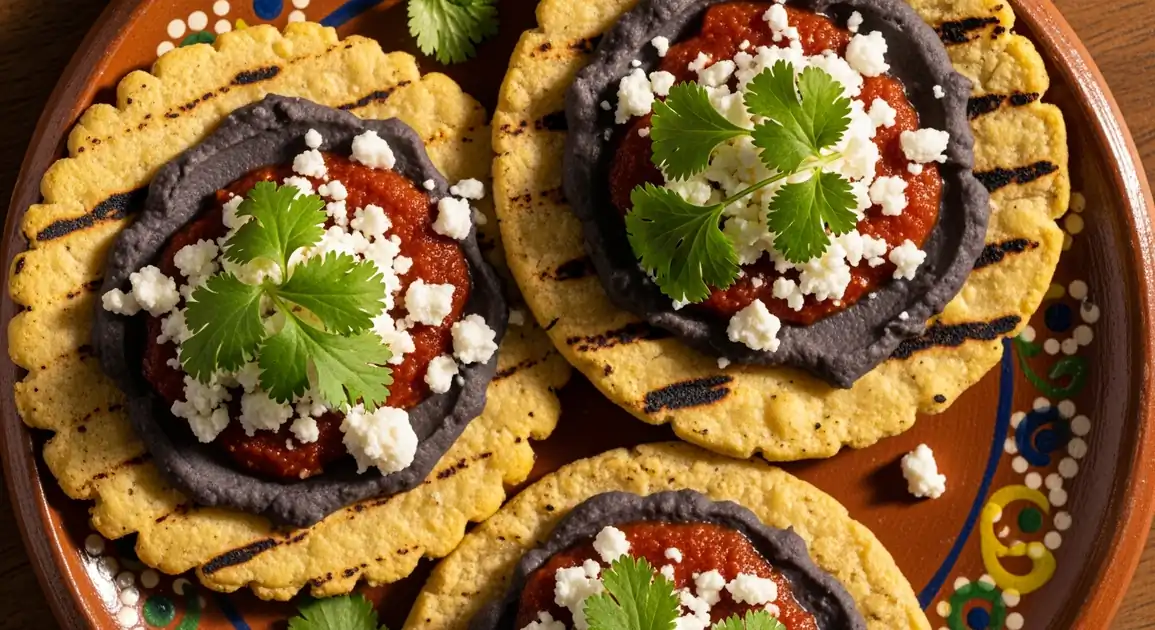Memelas
Memelas

Description
Memelas are found throughout Mexico but are particularly associated with Oaxacan cuisine. While the Oaxacan version with asiento and black beans is considered the most traditional, regional variations exist across the country, sometimes under different names. In Mexico City and other urban centers, Oaxacan restaurants and vendors have introduced memelas to wider audiences, though they're still most authentic in their home state.
Dietary Information
Serving information
Serving style
Typically served on small plates or wrapped in paper. Often accompanied by a selection of salsas. Usually eaten with hands, though some restaurants may provide utensils.
Quick facts
Most dedicated memela vendors operate 7 AM - 1 PM. Restaurant options available for longer hours.
Safety Tips
What to Look For
-
Fresh masa being prepared or formed by hand
Fresh masa ensures both better flavor and lower risk of contamination compared to masa that's been sitting out.
-
Hot, active comal (griddle) with sizzling food
A properly hot comal ensures thorough cooking, killing potential pathogens. The griddle should be hot enough that water would instantly sizzle.
-
Memelas cooked to order
Freshly cooked memelas are safest. Avoid places where premade memelas sit out for extended periods.
-
Clean preparation area with separated ingredients
Toppings should be in clean containers, ideally covered or refrigerated, especially cheese and prepared salsas.
-
Vendor using separate utensils for handling raw masa versus cooked food
This demonstrates good food handling practices and reduces cross-contamination risk.
What to avoid
-
Pre-made memelas sitting at room temperature
Memelas should be freshly made and served hot. Those sitting out can harbor bacteria.
-
Lukewarm or cool comal/griddle
Food safety depends on proper cooking temperatures. A griddle that's not hot enough won't properly cook the masa.
-
Unsanitary handling of money and food without handwashing
Look for vendors who either have separate people handling money or who wash/sanitize hands between handling money and food.
-
Visibly dirty preparation surfaces or utensils
Overall cleanliness is a good indicator of food safety practices.
-
Prepared toppings sitting unrefrigerated for long periods
Especially with cheese and salsas containing raw vegetables, refrigeration is important for items not being actively used.
Price information
Price range
Budget tips
- Prices typically range from 12-20 MXN per memela at street stands and local markets.
- Restaurants and tourist-oriented spots charge 25-50 MXN each.
- Order memelas as a pareja (pair) for better value.
- Adding premium toppings like tasajo (dried beef) or chorizo will increase the price.
Value indicators
- Hand-pressed, not machine-made.
- Freshly cooked to order.
- Generous portion of toppings.
- Properly thick masa with pinched edges.
- Homemade salsas rather than commercial ones.
Where to Find This Dish
Markets
Traditional markets throughout Mexico often have food sections with memela vendors.
Local mercados, Food halls
Morning, Early Afternoon
Street Food Areas
Areas known for street food typically have memela vendors, especially in the mornings.
Food stalls, Morning markets
Early Morning, Mid-Morning
Vendor Tips
- Many vendors specialize exclusively in corn-based antojitos like memelas.
- Look for vendors with women making masa by hand.
- The best stands often run out by late morning - arrive early!
How to Order
Regional Variations
-
Memelas with Tasajo
(Memelas con Tasajo)
Topped with thin slices of tasajo (air-dried beef), a Oaxacan specialty, in addition to the standard toppings.
-
Memelas with Chorizo
(Memelas con Chorizo)
Featuring crumbled Mexican chorizo, bringing a spicy, rich flavor to complement the traditional toppings.
-
Memelas with Chapulines
(Memelas con Chapulines)
For the adventurous, these feature chapulines (toasted grasshoppers), a traditional Oaxacan protein, adding a crunchy, nutty element.
-
Plain Memelas
(Memelas Sencillas)
A simpler version with just asiento (pork fat) and salt, sometimes served as a side to soups or main dishes.
-
Vegetarian Memelas
(Memelas Vegetarianas)
Made with vegetable oil instead of asiento, often topped with avocado, nopales (cactus), or squash blossoms alongside the beans and cheese.
Cultural context
History
Memelas have pre-Hispanic origins, dating back to ancient Mesoamerican cultures who developed nixtamalization (treating corn with lime) to create nutritious, workable masa. The name likely derives from Nahuatl, the Aztec language. For centuries, indigenous women in Oaxaca have prepared these simple corn cakes as an economical, filling food. While the base has remained relatively unchanged, the toppings evolved after Spanish colonization with the introduction of pork fat and cheese. Today, memelas remain a beloved traditional food and cultural touchstone in Oaxaca.
Local significance
Memelas represent the corn-based foundation of Mexican cuisine and the ingenious ways traditional cooks have created flavorful, satisfying foods from simple ingredients.
Eating customs
- Typically eaten by hand.
- Usually paired with coffee, hot chocolate, or atole in the morning.
- Often consumed alongside other antojitos in a small meal.